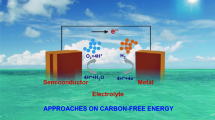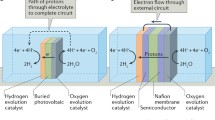Abstract
Using Sun’s energy effectively to drive important, industrially relevant chemical reactions is currently an area of research that is attracting a large attention. This route circumvents our reliance on non-renewable sources of energy and more importantly prevents the release of hazardous pollutants as a byproduct. One such reaction that has a large industrial relevance is the splitting of water to release hydrogen and oxygen. This is a thermodynamically energy intensive reaction, and the most relevant aspect is that hydrogen gas is the product which is being touted as a fuel of the future. Its energy density value is higher than other commercially relevant fuels, and its combustion only produces water as a byproduct with zero carbon footprint. Presented here are the current routes being considered for effective water splitting and the fundamental principles that need to be considered when pursuing new directions in this area.
Similar content being viewed by others
Suggested Reading
R Singh, Energy Sufficiency Aspirations of India and the Role of Renewable Resources: Scenarios for Future, Renewable and Sustainable Energy Reviews, Vol.81 No.2, pp.2783–2795, 2018.
S Jebaraj and S Iniyan, A Review of Energy Models, Renewable and Sustainable Energy Reviews, Vol.10 No.4, pp.281–311, 2006.
Y Chu, Review and Comparison of Different Solar Energy Technologies, Global Energy Network Institute, 2011.
M Pommier, H Fagerli, M Gauss, D Simpson, S Sharma, V Sinha, S D Ghude, O Landgren, A Nyiri and P Wind, Impact of Regional Climate Change and Future Emission Scenarios on Surface O-3 and PM 2.5 Over India, Atmospheric Chemistry & Physics, Vol.18 No.1, pp.103–127, 2018.
A Goetzberger, C Hebling, H W Schock, Photovoltaic Materials: History, Status and Outlook, Materials Science & Engineering R-Reports, Vol.40 No.1, pp.1–46, 2003.
M Gratzel, Solar Energy Conversion by Dye-sensitized Photovoltaic Cells, Inorganic Chemistry, Vol.44 No.20, pp.6841–6851, 2005.
D Gust, T A Moore and A L Moore, Solar Fuels via Artiicial Photosynthesis, Accounts of Chemical Research, Vol.42 No.12, pp.1890–1898, 2009.
N S Lewis, D G Nocera, Powering the Planet: Chemical Challenges in Solar Energy Utilization, PNAS, Vol.103 No.43, pp.15729–15735, 2006.
A Mutalikdesai, S K Ramasesha, Emerging Solar Technologies: Perovskite Solar Cell, Resonance, Vol.22, No.11, pp.1061–1083, 2017.
D J Vinyard, G M Ananyev and G C Dismukes, Photosystem II: The Reaction Center of Oxygenic Photosynthesis, Annual Review of Biochemistry, Vol.82, pp.577–606, 2013.
B Alberts et.al., Molecular Biology of the Cell, 4th Edition, Garland Science, 2001.
A Zouni et al., Nature, 409, pp.739–743, 2001
K N Ferreira, T M Iverson, K Maghlaoui, J Barber and S Iwata, Science, 303, 7 pp.1831–1838, 2004
Y Umena, K Kawakami, J R Shen, N Kamiya, Nature, 473, pp.55–60, 2011
M Suga et al., Nature 517, pp.99–103, 2015.
N Cox, D A Pantazis, F Neese and W Lubitz, Artiicial Photosynthesis: Understanding Water Splitting in Nature, Interface Focus, Vol.5, p.20150009, 2015.
Adapted from https://en.wikipedia.org/wiki/Energy_density
C W Forsberg, Future Hydrogen Markets for Large-scale Hydrogen Production Systems, Int. J. Hydrogen Energy., Vol.32, pp.431–439, 2007.
S Giménez, J Bisquert, Photoelectrochemical Solar Fuel Production: From Basic Principles to Advanced Devices, Springer, 2016.
Z W Seh, J Kibsgaard, C F Dickens, I Chorkendorff, J K Norskov and T F Jaramillo, Combining Theory and Experiment in Electrocatalysis: Insights into Materials Design, Science, Vol. 355, No.6321, pp.1–12, 2017.
X X Zou, Y Zhang, Noble Metal-free Hydrogen Evolution Catalysts for Water Splitting, Chemical Society Reviews, Vol.44, No.15, pp.5148–5180, 2015
W F Chen, J T Muckerman, E Fujita, Recent Developments in Transition Metal carbides and nitrides as hydrogen evolution electrocatalysts, Chemical Communications, Vol.49 No.79, pp.8896–8909, 2013.
V Viswanathan, H A Hansen, J Rossmeis, J K Nøorskov, Unifying the 2e and 4e− Reduction of Oxygen on Metal Surfaces, J. Phys. Chem. Lett., Vol.3 No.20, pp.2948–2951, 2012.
N T Suen, S F Hung and Q Quan, Electrocatalysis for the Oxygen Evolution Reaction: Recent Development and Future Perspectives, Chemical Society Reviews, Vol.46 No.2, pp.337–365, 2017.
K Maeda and K Domen, Photocatalytic Water Splitting: Recent Progress and Future Challenges, J. Phys. Chem. Lett., Vol.1, pp.2655–2661, 2010.
I Roger, MA Shipman, MD Symes, MDEarth-abundant Catalysts for Electrochemical and PhotoelectrochemicalWater Splitting, Nature Reviews Chemistry, Vol.1, No.1, 2017.
Y Q Qu, X F Duan, Progress, challenge and perspective of heterogeneous photocatalysts, Chemical Society Reviews, Vol.42, No.7, pp.2568–2580, 2013.
Author information
Authors and Affiliations
Corresponding author
Additional information
Deepa Khushalani is currently an Associate Professor at TIFR, Mumbai. Her area of specialization involves materials chemistry with emphasis on exploiting alternate sources of clean energy involving photovoltaics and energy storage devices. Her group also works on drug delivery devices, photocatalysis, and electrocatalysis. She is the recipient of the DST Nanoscience Young Investigator Award for 2016 and the CRSI Bronze Medal in 2018.
Rights and permissions
About this article
Cite this article
Khushalani, D. Exploiting Sun’s Energy Effectively as a Source of Renewable Energy. Reson 23, 355–369 (2018). https://doi.org/10.1007/s12045-018-0623-1
Published:
Issue Date:
DOI: https://doi.org/10.1007/s12045-018-0623-1




